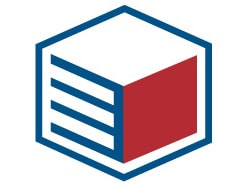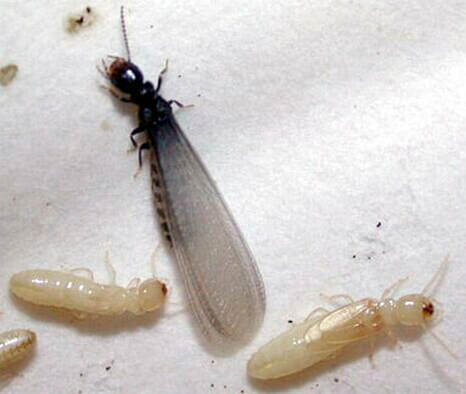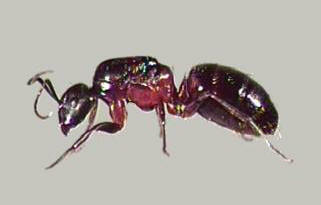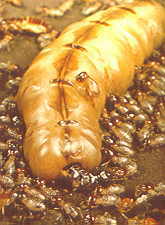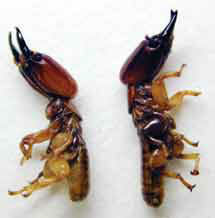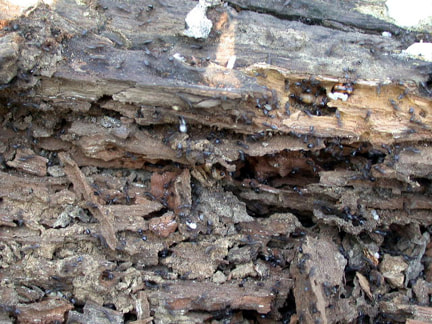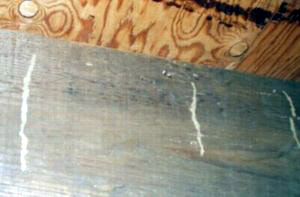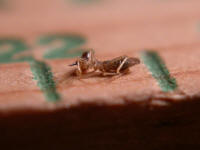|
25/2/2019 7 Comments termitesThe subterranean termite Reticulitermis flavipes (Kollar) is probably the most destructive and widely distributed species in North America. This species has acclimatized to southern Ontario to such a degree that 27 municipalities report some degree of infestation. Subterranean termites were first reported in Ontario at Point Pelee in 1929. It has subsequently been reported in Toronto (1938), Windsor (1950), Kincardine (1954), Oxley (1955), Amherstburg and Dresden (1968) and Guelph (1975). Presently in Metropolitan Toronto, the termite infested area extends through a radius of approximately 30 kilometers. In contrast to termites, carpenter ants do not eat wood and other cellulose-based materials, but instead simply excavate living quarters and hatching chambers that are usually quite limited in extent. Powder post beetles only do significant damage when multiple generations continually re-infest the same piece of wood. Also, powder post beetle damage is restricted to hardwoods, and since most structural framing is made of softwood lumber it is rarely attacked by these insects.
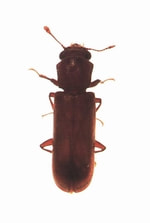 Several species of powder post beetles are to be found in the U.S. and Canada. They vary in length from 1/16" to 3/8", but generally have flattened bodies, a prominent head and segmented antennae. True powder post beetles attack only hardwoods (particularly oak, hickory, ash, walnut and cherry) but other species of wood boring beetles attack both hardwoods and softwoods. Powder post beetle larvae cause millions of dollars worth of damage in the US and Canada annually, and are almost as destructive as termites. Adult beetles lay their eggs in the surface pores of wood. The larvae bore into the wood as soon as they hatch. Living in the wood, they create tunnels called galleries as they eat their way through the timbers. When the larvae are nearly full grown, they bore near to the surface of the wood and pupate. The adults bore out through the surface soon after pupation, pushing a fine powdery wood dust, usually a copper to yellow-gold in color, out of the wood as they emerge.
The two wingless non-reproductive castes consist of the soldiers and workers. The soldiers defend the colony from outside attack, while the workers carry out all duties except defence and reproduction. For example, the workers feed the reproductives, larvae and soldiers, care for the eggs, and construct tunnels and shelter tubes. The soldier caste consists of sterile adults with large heads and pincher-like mouth parts. These soldiers make up 2-3 % of the total colony. There are three known methods by which a new termite colony may be established.
What you can do to prevent an infestation of termites:
Suppression of Termites Suppression refers to measures intended to reduce and eventually eradicate termites from infested materials in a designated area. Suppression methods include systematic location and destruction of colonies not associated with buildings (such as in street trees), systematic inspection of wood products leaving an infested area to quarantine the infestation, burning of infested lumber and heat treatment of reclaimed lumber. Site Management Careful site preparation and clean-up can do much to discourage the colonisation of a new or existing building site by termites. Where forest or orchard land has been cleared, tree roots must be completely excavated and removed along with any other buried wood. During construction, it is important that:
Chemical Treatment Before any chemical treatment can be done all wood in direct contact with the soil must be removed from the property. Conventional treatment for termite control requires the services of a licensed exterminator. Several firms in Ontario are qualified, and your Yellow Pages or a Local Search will assist you in locating companies in your area. Chemical treatment takes approximately one full day, and involves four distinct phases:
Soil Barriers The environmental and health risks associated with chemical usage have led to the withdrawal of several termiticide products from the market. Barriers consisting of a layer of precisely sized sand or crushed stone below and around foundations are an alternative means of preventing termite entry. Building Design Foundation walls and slabs should be designed to inhibit the entry of termites into the building, and to facilitate inspection for shelter tubes. Sheet metal and steel mesh barriers properly designed and installed, are also an effective means of control. Wood products and other building materials should be selected with regard to termite resistance. Bait, Trap and Release Baiting involves placing bait tubes or traps in the ground at intervals around a building -several dozen for a typical house. Pieces of untreated timber or other cellulose-based material are inserted into these tubes as bait for termites. The tubes are monitored and, when termites are observed feeding on the bait, it is replaced with treated bait containing a chemical that the termites then carry back to the colony. The chemical is slow acting, so termites are unable to associate its source with its effects. Over a period of several months, the entire colony may be destroyed. When no further activity is observed in the bait stations, treated bait is removed, and replaced with untreated bait. Monitoring continues on a regular basis, and the procedure is repeated as necessary. Several companies offer products and services that are variations on this method of site treatment, although baiting is still a relatively new approach for termites. Points to Remember
Checklist for Staying Termite-free If you live in a termite-prone area, assess your hazard exposure and use the information here to develop a termite management strategy that includes some or all of the control measures presented. Termite management is an ongoing process that with constant vigilance and maintenance can save a lot of trouble, worry and money.
7 Comments
Leave a Reply. |
AuthorGil Strachan is a professional home inspector, representing Electrospec Home Inspection Services in east-central Ontario since 1994. CategoriesAll Appliances Buying And Selling Cooling Electrical Environmental Exterior Health And Safety Heating Home Improvement Home Inspection Insulation Insurance Interior Plumbing Roofing Special Structure Archives
January 2024
|
